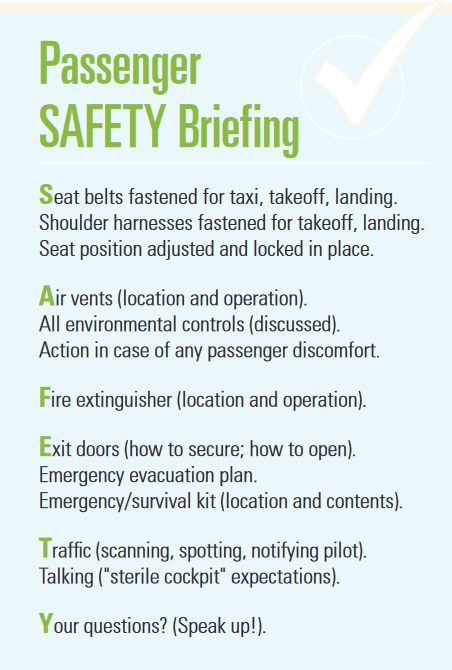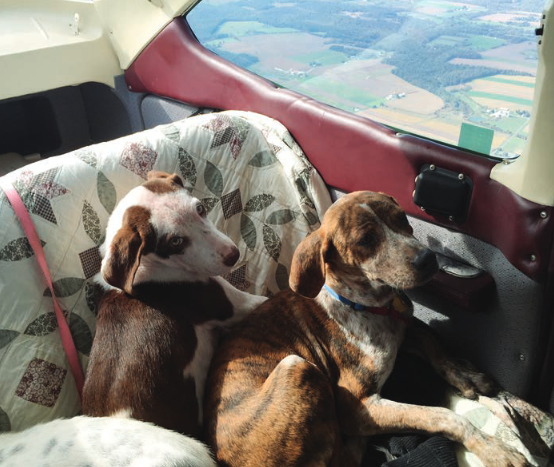Flying with Mates, Munchkins, and Mutts
Tips for Keeping Your Passengers Safe — and Happy
by Brad Zeigler, FAA Aviation Safety Analyst
Source: FAA Safety Briefing Mar/Apr 2018
Pre-flight the Preflight
My wife and I often drive separately when our family travels. I leave for the airport early with the luggage, and she comes a bit later with the dog and our 3-year old son. That way I have the time to do a thorough walk-around, arrange for fuel, check the paperwork, load the luggage, install the child safety seat, file my flight plan, and mentally prepare for the flight. My wife simply parks her car, arranges a last minute potty break, and hops in, while I load up the dog and the toddler. My experience suggests that toddlers (and really kids of any age) don’t like waiting around. My wife feels like a rock star because she shows up, and we’re in the air less than 10 minutes later.
Brief the Flight
Whether it’s their first or four thousandth flight with you, be sure to brief your passengers in age-appropriate language about what your plan for the flight is, what they can and cannot do during the flight, when it’s okay to speak, etc., as well as how to exit the airplane quickly if necessary. I generally avoid the words “in the event of an emergency” in my briefings, but make sure I cover everything that needs to be covered. Some pilots provide passenger safety briefing cards, which may be useful depending on the passenger.
Make the First Flight Short … but With a Purpose
Someone who’s never been in a small plane before may have many preconceived notions of how the experience will play out. No doubt they have concerns for safety, their ability to keep their lunch down, etc. I try to keep the flight as “boring” as possible — shallow bank turns, smooth gradual maneuvers, and slow, ear-friendly descents. No need to impress anyone with the maneuverability of your plane — we’re building trust, not trying to shake off attacking MiGs. While the flight may be “boring,” make sure it has a purpose. That could be flying over a familiar town, scenic area, or the proverbial “Benjamin Burger” at another airport close by.
Pair a Newbie with a More Experienced Passenger
This tip doesn’t work in a two-seat aircraft, but one way to take the stress off of a new passenger is to bring someone else along — ideally a trustworthy person such as a parent or a friend — to join the first-timer. The new passenger will look to the experienced passenger for cues. Something as simple as a flap movement or an autopilot disconnect alert may initially cause alarm to the newbie; seeing the experienced friend’s nonchalance will provide comfort. Also, they can answer questions when the pilot is busy.
Keep Them Safe and Comfortable
If your little ones need a child safety seat in the car, then you need the same in the airplane. Practice ahead of time on how to install it; most GA aircraft won’t have the LATCH connections so you’ll need to make sure it’s secured with the safety belts. Consult the child safety seat manufacturer and/or the aircraft flight manual/operating handbook for more information. For everyone else, make sure they know how to work the safety restraints since they’re usually different from what passengers are used to in the car.
Make sure everyone has some form of hearing protection that fits, whether or not they’re old enough to have a headset that plugs into the intercom. You can even find hearing protection for babies nowadays.
Pro tip: Get the little ones accustomed to keeping the headset on before you make it to the plane. Fighting with your toddler to keep it on is not fun for anyone.

Explain What You’re Doing … but Don’t Overdo It
One thing that passengers love about flying in GA aircraft is the ability to actually see how the pilot flies the airplane. They’ll be watching what you do and wondering why you do it. Use terms that they can understand: a traffic pattern at an airport is a lot like a traffic circle on a roadway; it allows planes to enter and exit while continuously moving. They’ll wonder about your radio calls, the intercom system, and whether the “tower” can hear them talking through it. You’ll explain that only you can be heard outside the aircraft, and only when you key the mike.
What you want to avoid is long, esoteric explanations of aerodynamic concepts (unless your passenger happens to be an aeronautical engineer). Stick to simple concepts. Avoid unnecessary detail that could alarm a passenger. Describing “carb heat” as a “system that allows the carburetor to be effective in all operating conditions” is probably better than “if I don’t pull this lever the engine will stop, and we’ll have to land in the trees.”
Manage Expectations
Compared to the airlines, most GA airplanes are much more limited in the type of weather they can fly in, even if the pilot is instrument rated. Further, we don’t always have a backup airplane available if we experience a mechanical issue. Between the plane, the weather, and the pilot’s personal minimums, there are many possibilities in which a flight might need to be canceled. Explain to your passengers ahead of time that there’s the possibility that the flight might not take place as planned. If the destination is a “must reach” event like a wedding, funeral, etc., and time is limited, you need to consider other means of travel.
Plan Your Flights Strategically Regarding Weather — Have a Plan B (C and D too)
In the summer, flying at the crack of dawn usually results in the smoothest air and least likelihood of thunderstorms. Remember, we want to keep these flights boring, right? If the trip is a longer one, it’s not a bad idea to have an alternative travel plan in case the flight gets scrubbed. Keep the car gassed up, cash-in your frequent flier miles, or plan an alternate activity. We never want to disappoint our passengers, but if we manage expectations and have a backup plan, we are less vulnerable to get-there-itis.
Plan Around Toddler Naptimes, and Bring Snacks
While naps may be more appropriate to our younger passengers, everyone gets grumpy if they get too hungry. If your little ones fall asleep in a moving car, chances are they’ll be out before you even climb to pattern altitude. When they’re young, planning a flight around naptime is a great way for everyone to arrive rested and happy. Also, if you have little ones, bring plenty of wipes for clean up, and trash bags to pack everything out.
Keep Your Passengers Involved … or Let Them Do Their Own Thing
When my wife flies with me, she wants as little to do with the operation of the flight as possible. When our son was born, she moved to the back seat and hasn’t returned to the front row. If she’s not interacting with him, she’s listening to music or reading a book. That’s OK. For other passengers, I find assigning tasks can be helpful. A lot of fellow pilots report success bribing their kids to spot other planes. The front seat passenger might follow along on the aeronautical chart. Your math wiz might enjoy calculating winds aloft or figuring real-time fuel burn. A busy passenger is a happy passenger, which leads me to …
Don’t Let Your Passengers Become a Distraction for You
Many of the other tips I’ve mentioned help prevent passengers from becoming distractions. As a general rule, most hazards from passengers can be mitigated with proper planning. You should be confident that your front seat passenger is not going to grab the flight controls or pull the mixture lever. Briefing your passengers on sterile cockpit procedures can help minimize distractions, but a “pilot isolate” button on the intercom is helpful too.
Bonus Tips on Flying with Your Mutt

Know Your Dog
How your dog behaves in the car is a great indicator of how they’ll do in-flight. If your pooch is known to get sick just by looking at your car, you might want to skip that flight. However, if they can’t wait to jump in the car for the ride to the airport, chances are they’ll love the plane too.
Make a Spot in the Plane for Your Dog
Dogs are pack animals and like cozy, secure spots. A familiar travel crate, or even a spot in the cargo area with plenty of blankets will do. For everyone’s safety, you’ll want to secure your pooch pal.
If you can get your dog to tolerate canine hearing protection gear, that’s great. Not all dogs will, but making a comfortable space in the plane with blankets will help them a great deal with the noise and motion of the new environment.
Bring a Human Flight Attendant
Especially if your dog doesn’t have a lot of GA flight experience, a human flight attendant can be a big help. As a pilot, you need to focus on the flying, and a dog who is not handling the flight can be a big distraction.
Be Strategic with Food and Water
Don’t starve or dehydrate your pooch, but minimize large intakes of food and water prior to takeoff. Remember, gas in the body expands at altitude. Limit the duration of the flight and plan for interim stops on longer flights to give your doggy a chance to stretch his legs (and perhaps mark some territory at the same time).
Brad C. Zeigler is an aviation safety analyst with the General Aviation and Commercial Division. He is also an Airline Transport Pilot, Certificated Flight Instructor and frequent Cessna 182 flyer around the Washington, D.C., area.
|